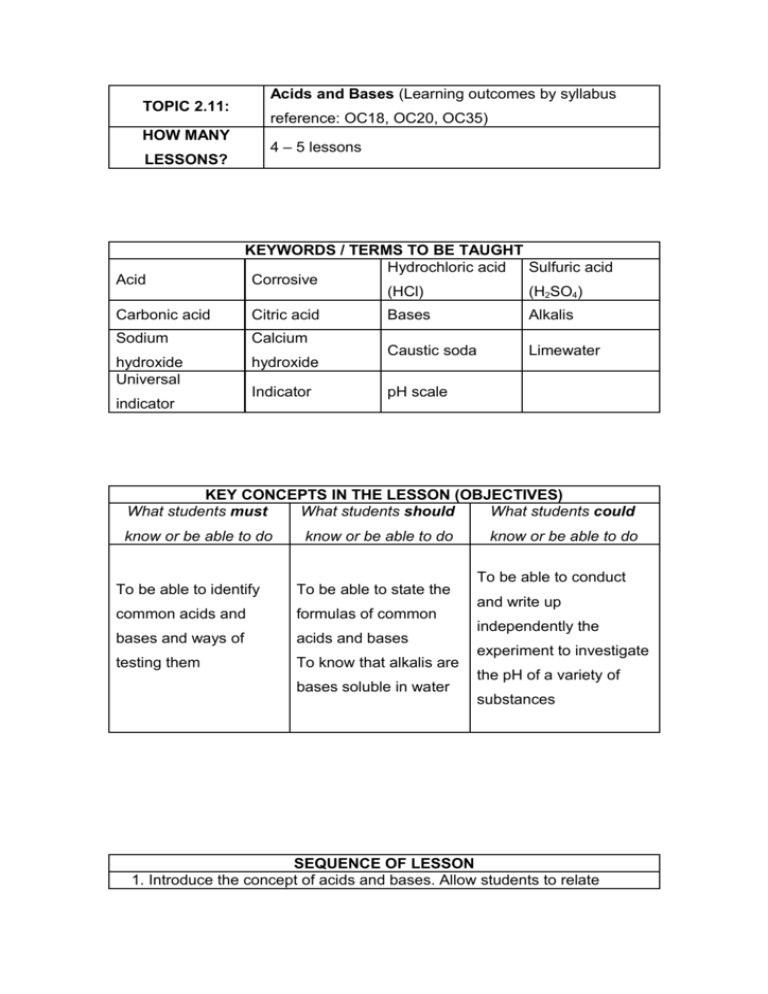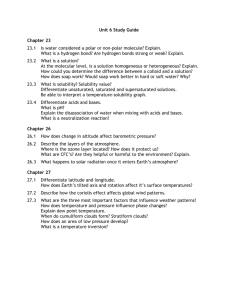TOPIC 2.11: Acids and Bases (Learning outcomes by syllabus
advertisement

Acids and Bases (Learning outcomes by syllabus TOPIC 2.11: reference: OC18, OC20, OC35) HOW MANY 4 – 5 lessons LESSONS? Acid KEYWORDS / TERMS TO BE TAUGHT Hydrochloric acid Sulfuric acid Corrosive (HCl) (H2SO4) Carbonic acid Citric acid Sodium Calcium hydroxide Universal hydroxide indicator Indicator Bases Alkalis Caustic soda Limewater pH scale KEY CONCEPTS IN THE LESSON (OBJECTIVES) What students must What students should What students could know or be able to do know or be able to do To be able to identify To be able to state the common acids and formulas of common bases and ways of acids and bases testing them To know that alkalis are bases soluble in water know or be able to do To be able to conduct and write up independently the experiment to investigate the pH of a variety of substances SEQUENCE OF LESSON 1. Introduce the concept of acids and bases. Allow students to relate personal knowledge of acids and bases This could be facilitated by using the Acids and Bases Introduction PowerPoint and encouraging student input during the presentation. 2. Carry out experiments in groups. Discussion of key vocabulary, results and conclusions. Students record results and write up experiments as they are doing the practical work through the use of text and/or pictures. 3. Review – whole class discussion. Possibility of using Acids and Bases Quiz PowerPoint to facilitate student understanding 4. Further class work/ homework – see Acids and Bases Worksheet. 1. DIFFERENTIATE BY CONTENT (In what ways can I vary the content of what I am teaching?) (A) Complexity of content: (concrete, symbolic, abstract) Concrete Symbolic Abstract Real materials associated with acids and bases (e.g. lemons, toothpaste, Diagrams of colour charts to read pH How indicators work soap, litmus, indicator etc.) (B) Variety of resources As listed above (C) Variety of learning environments Classroom, school laboratory, computer room, outdoor trip to test pH of rainwater, soil etc 2. DIFFERENTIATE BY PROCESS (How will I teach the lesson?) Sequence of lesson as laid out above Introduction – using concrete or symbolic material or a general class discussion Divide class into groups. Assist students, as required, in completing the experiments to test acids and bases. For resources, guidance and support related to facilitating student experiments and investigations, see www.juniorscience.ie Possible use of the What am I? activity in the Classroom Activities section of this resource pack, to facilitate discussion. 3. DIFFERENTIATE BY OUTCOME / PRODUCT (How will the student demonstrate understanding?) See Worksheets, Classroom Activities and Experiments sections of this resource pack. • Whole class review work completed at end of class. • Homework: Acids and Bases Worksheet if not used for class work. Specify time to be allocated to this work at home. • FINALLY - ANY OTHER POSSIBILITIES FOR THIS LESSON? Sorting game using pictures of common acids and bases • Collage of scenes showing acids and bases with their approximate pH • Extension exercise: How do indicators work? • Suggested Internet links include www.juniorscience.ie, www.bbc.co.uk/schools, www.scoilnet.ie, www.skoool.ie and http://classroom.jc-schools.net/sci-units/matter.htm









